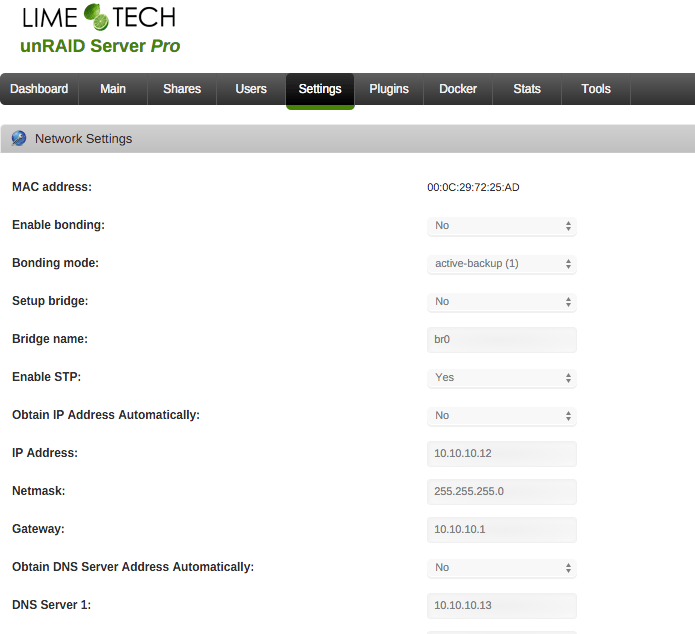

- #UNRAID SETUP NETWORK FULL#
- #UNRAID SETUP NETWORK SOFTWARE#
Did I really need two separate servers? I had a few weeks off of work, so I decided to work on combining the two into one MegaServer running Unraid. The funny thing was, I wasn't pushing either box all that hard. For almost a year, I had two servers sitting in my home office. So I built a new computer just to be a hypervisor. I needed more VMs than I thought my Unraid box could handle. This is where my misunderstanding of hypervisors came in. At first, I used Unraid as both my NAS and a simple hypervisor. That misunderstanding caused me to end up building two servers. When I started, I had some fundamental misunderstandings on how hypervisors work. Specifically, how I built a NAS and a hypervisor to host a bunch of VMs for a test lab. What I want to focus on for this post is how I built the infrastructure to help me work from home more efficiently. I'll get into those differences in later posts. As expected, working from home is a lot different than working in an office.

The client sends its request and then shuts up.I've been working from home since April of 2018 for Octopus Deploy.
Low overhead -> Better Battery Life- WireGuard, as described by its developer, isn't a chatty protocol. You can find instructions by Googling, " + dynamic DNS" or implementing it directly in Unraid with the legendary SpaceInvader One's guide: Let's begin! WireGuard Implementation on Unraid Prerequisites:ĭynamic DNS Configured- This is outside of the scope of this guide, but thankfully it's relatively simple and available on most routers. Hopefully by now I've convinced you to implement WireGuard and you're ready to deploy the WireGuard plug-in on Unraid. #UNRAID SETUP NETWORK FULL#
It even works across full IP address changes such as when I change hotspots from AT&T to T-Mobile. In contrast, WireGuard rapidly re-establishes connection without me even knowing. I've noticed that WireGuard gives many of the same benefits and when I have a poor network connection in a coffee shop (honestly, are there any coffee shops with good wifi connections?), with OpenVPN, I would continue working only to find my connection had been dropped and would be interrupted by OpenVPN attempting to reconnect. Mosh allows you to roam seamlessly between IP addresses and bad network connections.
Mosh-like Connectivity- This is part of my core stack for remote development. Anecdotally, in my own testing, I am noticing about a 2-3 hour improvement in battery life when working remotely at a coffee shop on WireGuard compared to OpenVPN. (An idle wifi card uses something like ~20 mW at idle but can easily climb to ~2W under load). As a result, when you're working on a laptop on wireless, your wireless card has a higher likelihood of being able to idle down which leads to better battery life. It tries to avoid keep alive handshakes if they're not needed. The client sends its request and then shuts up. It allows you secure access to your homelab in the event that something happens and you need to remote in. Redundancy- As I have spoken about in the past, a VPN is an essential component of the Unattended Server Checklist. VPNs allow you to minimize your network's attack surfaces to a single (very secure) port forward for the VPN server. Do this enough times and the firewall that separates your home network from the internet starts to look like swiss cheese with all of the holes you've punched through it with those port forwards. If you don't utilize a VPN, then you have to port forward to make your Unraid homelab's local resources available over the internet. In doing so, this allows you to access all of your network's resources locally. Security- A VPN makes your remote laptop just another device on the network, just as if you were at home. With WireGuard, we're talking 15 minutes tops, assuming you have the prerequisite dynamic DNS already set up (if not, add maybe another 30 minutes). Even with all of the great guides available, you still have to know what you're doing. This stands in stark contrast to deploying the OpenVPN Docker container which, while certainly faster than deploying an OpenVPN server from scratch, still takes some effort. Rapid VPN Deployment- If you're new to Unraid or haven't otherwise deployed a VPN, the biggest reason to implement WireGuard is that it's extremely fast to deploy. In short, WireGuard is a lightweight VPN server/client embedded in the Linux kernel. From those of us new to homelabs to those of us with advanced setups, I am of course talking about WireGuard®. Unraid 6.8 was recently released and one of the main new features is a game changer for us all. #UNRAID SETUP NETWORK SOFTWARE#
He uses it as network-attached storage for various hardware and software development projects.

This guest blog is by TorqueWrench of the Engineer's Workshop who has been using Unraid since 2017.







 0 kommentar(er)
0 kommentar(er)
